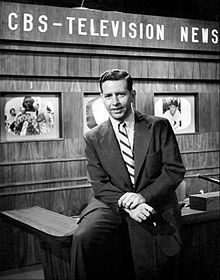Douglas Edwards
| Douglas Edwards | |
|---|---|

Edwards on the set of Douglas Edwards With the News (1952)
|
|
| Born |
July 14, 1917 Ada, Oklahoma, U.S. |
| Died | October 13, 1990 (aged 73) New York City, New York, U.S. |
| Occupation | Television and radio broadcaster, news anchor |
| Years active | 1942–1988 |
Douglas Edwards (July 14, 1917 – October 13, 1990) was an American network news television anchor. He anchored CBS's first nightly news broadcast from 1948–1962, which was later to be titled CBS Evening News.
A native of Oklahoma, Edwards grew up in Birmingham, Alabama. Edwards joined CBS Radio in 1942, eventually becoming anchor for the regular evening newscast The World Today as well as World News Today on Sunday afternoons. Edwards came to CBS, after stints as a newscaster and announcer at WSB in Atlanta, Georgia and WXYZ in Detroit, Michigan.
In the mid-1940s, Edwards was host of the radio program Behind the Scenes at CBS.
In 1948, as CBS's top correspondents and commentators shunned the fledgling medium of television, Edwards was chosen to present regular CBS television news programs and to host CBS's television coverage of the 1948 Democratic and Republican conventions. The term "anchor" would not be used until 1952, when CBS News chief Sig Mikelson would use it to describe Walter Cronkite's role in the network's political convention coverage.
At first, Edwards would be eclipsed by John Cameron Swayze of NBC News's Camel News Caravan, but he would eventually regain his ratings lead. By the mid-1950s, the nightly 15-minute newscast Douglas Edwards with the News was watched by nearly 30 million viewers.
Among the events Edwards covered as a reporter in those years were the Miss America Pageant (five times), the attempted assassination of Harry S. Truman in November 1950, and the coronation of Elizabeth II in June 1953. He also received wide praise for his coverage, on both camera and radio, of the sinking of the SS Andrea Doria in July 1956. But by the end of the decade, viewership levels for the Edwards broadcast weakened severely as the Huntley-Brinkley Report began to attract a larger audience.
...
Wikipedia
